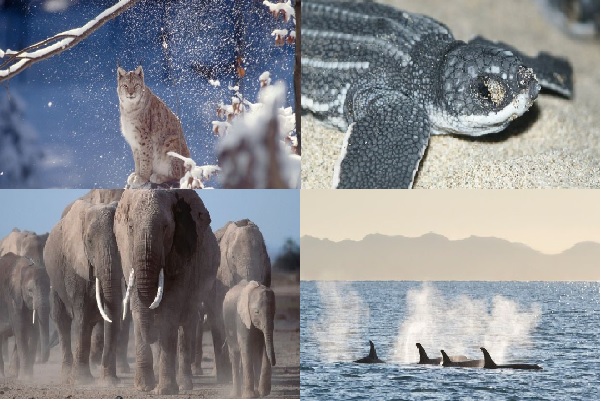World wildlife 'falls by 58% in 40 years'
Thu 27 Oct 2016, 14:59:21

Global wildlife populations have fallen by 58% since 1970, a report says.
The Living Planet assessment, by the Zoological Society of London (ZSL) and WWF, suggests that if the trend continues that decline could reach two-thirds among vertebrates by 2020.
The figures suggest that animals living in lakes, rivers and wetlands are suffering the biggest losses.
Human activity, including habitat loss, wildlife trade, pollution and climate change contributed to the declines.
Dr. Mike Barrett. head of science and policy at WWF, said: "It's pretty clear under 'business as usual' we will see continued declines in these wildlife populations. But I think now we've reached a point where there isn't really any excuse to let this carry-on.
"We know what the causes are and we know the scale of the impact that humans are having on nature and on wildlife populations - it really is now down to us to act."
However, the methodology of the report has been criticized.
The Living Planet Report is published every two years and aims to provide an assessment of the state of the world's wildlife.
This analysis looked at data collected on 3,700 different species of birds, fish, mammals, amphibians and reptiles - about 6% of the total number of vertebrate species in the world.
The researchers then analyzed how the population sizes had changed over time since 1970.
The last report, published in 2014, estimated that the world's wildlife populations had halved over the last 40 years.
This assessment suggests that the trend has continued: since 1970, populations have declined by an average of 58%.
Dr. Barrett said some groups of animals had fared worse than others.
"We do see particularly strong declines in the freshwater environment - for freshwater species alone, the decline stands at 81% since 1970. This is related to the way water is used and taken out of fresh water systems, and also the fragmentation of freshwater systems through dam building, for example."
It also highlighted other species, such as African elephants , which have suffered huge declines in recent years with the increase in poaching, and sharks, which are threatened by overfishing.
If pressures - overexploitation, illegal wildlife trade for example - increase or worsen, then that trend may be worse
Dr. Robin Freeman,
ZSL
ZSL
The researchers conclude that vertebrate populations are declining by an average of 2% each year, and warn that if nothing is done, wildlife populations could fall by 67% (below 1970 levels) by the end of the decade.
However, Living Planet reports have drawn some criticisms.
There are some numbers [in the report] that are sensible, but there are some numbers that are very very sketchy
Stuart Pimm, Duke University
Stuart Pimm, professor of conservation ecology at Duke University in the United States, said that while wildlife was in decline, there were too many gaps in the data to boil population loss down to a single figure.
"There are some numbers [in the report] that are sensible, but there are some numbers that are very, very sketchy," he told BBC News.
"For example, if you look at where the data comes from, not surprisingly, it is massively skewed towards western Europe.
"When you go elsewhere, not only do the data become far fewer but in practice, they become much, much sketchier... there is almost nothing from South America, from tropical Africa, there is not much from the tropics, period. Any time you are trying to mix stuff like that, it is is very very hard to know what the numbers mean.
"They're trying to pull this stuff in a blender and spew out a single number.... It's flawed."
But Dr. Freeman said the team had taken the best data possible from around the world.
"It's completely true that in some regions and in some groups, like tropical amphibians for example, we do have a lack of data. But that's because there is a lack of data.
"We're confident that the method we are using is the best method to present an overall estimate of population decline.
"It's entirely possible that species that aren't being monitored as effectively may be doing much worse - but I'd be very surprised if they were doing much better than we observed. "But that's assuming things continue as we expect. If pressures - overexploitation, illegal wildlife trade, for example - increase or worsen, then that trend may be worse.
"But one of the things I think is most important about these stats, these trends are declines in the number of animals in wildlife populations - they are not extinctions. By and large, they are not vanishing, and that presents us with an opportunity to do something about it."
No Comments For This Post, Be first to write a Comment.
Most viewed from International
Most viewed from World
AIMIM News
Latest Urdu News
Most Viewed
May 26, 2020
Do you think Canada-India relations will improve under New PM Mark Carney?
Latest Videos View All
Like Us
Home
About Us
Advertise With Us
All Polls
Epaper Archives
Privacy Policy
Contact Us
Download Etemaad App
© 2025 Etemaad Daily News, All Rights Reserved.

.jpg)
.jpg)








.jpg)

.jpg)
.jpg)
.jpg)
.jpg)
.jpg)
.jpg)
.jpg)
.jpg)
.jpg)
.jpg)



















